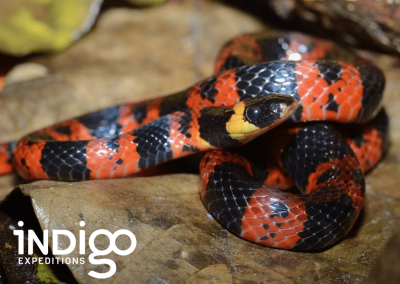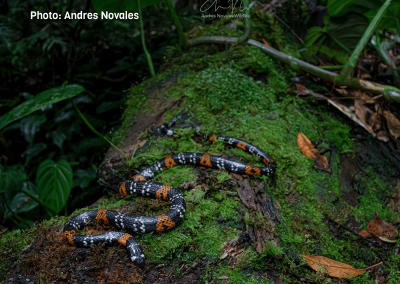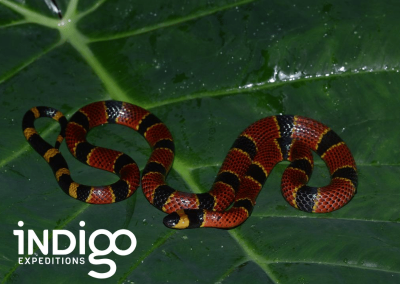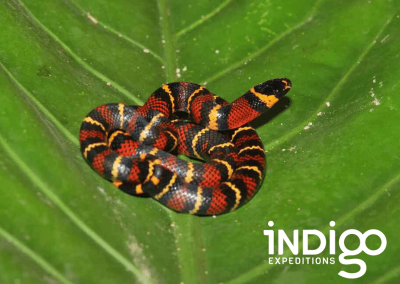Red to black venom lack. Red to yellow kill a fellow.
Another species I was very excited to find is the variable coral snake (Micrurus diastema). As its common name suggests its colouration and pattern are highly variable. Due to this fact, I treat any snake with any hint of bands of red / orange, yellow / white, and black as a coral snake until I am sure what it is. Coral snakes are highly venomous and so getting the identification correct is critical.
The diagnostic rhyme “red to black venom lack, red to yellow kill a fellow” is not enough for me to be certain that what I am looking at is safe to handle freely. The ‘Venom Lack’ rhyme originated in the US where it holds true, however as soon as you pass south of the border the picture starts to get rather confusing.
This is well illustrated by the variable coral snake, which in most cases fits the rhyme, red bands touch yellow, however, in some individuals, yellow bands are absent so red touches black, and even other case bands are absent altogether except for a single black band around the neck – again red touches black. In other coral snakes, such as the elegant coral snake (Micrurus elegans), red always touches black.
And that’s just the coral snakes. In the tropical regions of the America’s we also encounter many species of harmless snakes that look like coral snakes, some of which like the false coral snake (Pliocercus elapoides) have banding patterns where red touches yellow. Because of this, there have been several times where I almost convinced myself that what I was looking at was a coral snake, when in fact it was a harmless look-a-like!
Finally, after many false starts, I caught the first coral snake here at Las Guacamayas last week. Its colouration was almost identical in shade and pattern as the milk snake (Lampropeltis abnorma) I had caught the week earlier. The only real difference between them is the order of the bands, the size of the eyes and the scalation (e.g. coral snakes have far fewer rows of dorsal scales than milk snakes).
I will still remain on the cautious side when I see a red/black/yellow snake, even if it is not obviously a coral snake!
Indigo Archives: First Published 1 December 2013
False coral snake
The false coral snake (Pliocercus elapoides) is probably one of the best coral snake mimics. Although the species is mildly venomous, it is harmless to humans. Some populations have red touching black, while others red touching yellow.
Elegant coral snake
The elegant coral snake (Micrurus elegans) has an unusual pattern. In this species there is white not yellow! and to make matters more complicated those white bands are set in between the black bands not the red. Credit: Andres Novales.
Elegant coral snake
The elegant coral snake (Micrurus elegans) has an unusual pattern. In this species there is white not yellow! and to make matters more complicated those white bands are set in between the black bands not the red. Credit: Andres Novales.
Coffee snake
The black markings of this coffee snake (Ninia sebae) are often bordered by some very subtle yellow, meaning that red touches yellow, however, these calm little snakes are completely harmless to humans.
False coral snake
The false coral snake (Pliocercus elapoides) is probably one of the best coral snake mimics. Although the species is mildly venomous, it is harmless to humans. Some populations have red touching black, while others red touching yellow.
Variable coral snake
The variable coral snake (Micrurus diastema) is a classically coloured individual with red touching yellow, however in some individuals the yellow bands are absent and so red touches black.
Coffee snake
The black markings of this coffee snake (Ninia sebae) are often bordered by some very subtle yellow, meaning that red touches yellow, however, these calm little snakes are completely harmless to humans.
Variable coral snake
The variable coral snake (Micrurus diastema) is a classically coloured individual with red touching yellow, however in some individuals the yellow bands are absent and so red touches black.
Variable coral snake
The variable coral snake (Micrurus diastema) is a classically coloured individual with red touching yellow, however in some individuals the yellow bands are absent and so red touches black.
Milk snake
Non-venomous milk snakes like this one (Lampropeltis abnorma) are classic coral snake mimics where the black bands are bordered by yellow and red – and so in this case red touches black.
Milk snake
Juvenile milk snakes (Lampropeltis abnorma) have much brighter colours than the adults (left), they are also very similar in size to variable coral snakes. This means it can be very easy to mistake a young milk snake with a coral snake.


























0 Comments